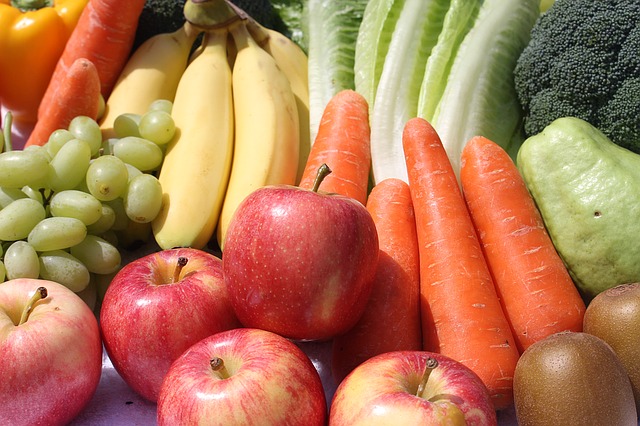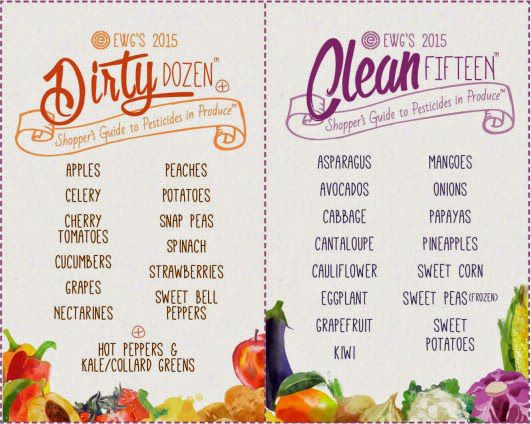Each year the Dirty Dozen and Clean Fifteen are reported by the EWG (Environmental Working Group) in their ‘Shopper’s Guide to Pesticides in Produce.’ It’s really good to know which produce is most important to look for organic when grocery shopping.

The Dirty Dozen
These are the top 12 fruits and veggies that carry the highest pesticide loads (testing positive for multiple types of pesticide residues at higher concentrations) and are safest to eat organic:
Apples, peaches, nectarines, strawberries, grapes, celery, spinach, sweet bell peppers, cucumbers, cherry tomatoes, imported snap peas, and potatoes.
Important to note: In addition to the Dirty Dozen, kale, collard greens, and hot peppers showed frequent contamination of pesticides toxic to the nervous system. It’s highly recommended to buy organic if consuming a lot of these types of vegetables. For those interested in cold hard facts here are some significant findings referenced from EWG’s website:
- 99 percent of apple samples, 98 percent of peaches, and 97 percent of nectarines tested positive for at least one pesticide residue.
- The average potato had more pesticides by weight than any other produce.
- A single grape sample and a sweet bell pepper sample contained 15 pesticides.
- Single samples of cherry tomatoes, nectarines, peaches, imported snap peas and strawberries showed 13 different pesticides apiece.
The Clean Fifteen
Well now that we’re done with the dirty ones, let’s move on to the clean fruits and veggies! Or should I say the cleaner ones. These are the top 15 that carry the least pesticides (testing revealed relatively few pesticide residues at low concentrations):
Avocados, sweet corn, pineapples, cabbage, frozen sweet peas, onions, asparagus, mangos, papayas, kiwi, eggplant, grapefruit, cantaloupe, cauliflower, and sweet potatoes.
Significant facts referenced from EWG’s website:
- Avocados were the cleanest: only 1 percent of avocado samples showed any detectable pesticides.
- Some 89 percent of pineapples, 82 percent of kiwi, 80 percent of papayas, 88 percent of mango and 61 percent of cantaloupe had no residues.
- No single fruit sample from the Clean Fifteen tested positive for more than 4 types of pesticides.
- Multiple pesticide residues are extremely rare on Clean Fifteen vegetables. Only 5.5 percent of Clean Fifteen samples had two or more pesticides.
Here are some handy dandy cheat sheets :)

But What if I Wash and Peel My Produce?
Before EWG’s testing begins the produce is washed, and if it needs peeling to be eaten (like a banana), peeled before testing. The idea is to prepare the produce the way it is normally eaten. So unfortunately washing or peeling produce doesn’t change pesticide residue. The other big question is: With all these pesticides should we even eat fruits and vegetables?
The short answer is YES! The benefits of a healthy diet rich in fruits and vegetables far outweigh the risks of pesticide exposure. Eating conventional produce is a much better option than not eating any fruits and vegetables at all. However, as much as your budget allows it is highly recommended to buy as much organic produce as possible, at the very least any of the dirty dozen.
I shop for most of my produce at my local farmer’s market but when I do shop at major grocery stores I oftentimes find that the conventionally grown produce is the same price if not MORE expensive than the organic version! So it’s not always best to assume that just because it’s organic, it must be more expensive.
How Concerning are Pesticides?
To simplify it, pesticides are toxic substances designed to kill living organisms. If it sounds pretty detrimental it’s because it is. Plenty of researchers and physicians have linked pesticides to several health issues such as cancers, hormone disorders, skin, eye and lung irritations, and brain and nervous system toxicity. And still there is much more to be learned regarding the burden of pesticides on the body.
Perhaps most alarming is the effect on developing children. A particular type of pesticides used on some fruits and vegetables, organophosphates have been the focus of long term-studies. Children with high exposure are at greater risk for damaged nervous system function which can result in impaired learning/brain development.
Furthermore, a link between American children exposed to typical levels of organophosphates and increased risk for ADHD has been found. Add to that the dangers of GMOs and organic produce becomes that much more appealing.
No doubt, the best way to avoid pesticides is to eat organic produce. It’s awesome that more consumers are casting their votes by spending on pesticide free produce, which in turn supports environmentally-friendly and sustainable farming efforts. This is evident by the fact that organic produce sales have nearly tripled in the last 10 years, increasing by 11 percent between 2013-2014 alone.
Where’s the Best Place to Buy Organic Produce?
Local farmer’s markets are the best place to buy produce since you can ask where and how the produce is grown. Many times farmers are using pesticide free practices but don’t want to pay the cost to become certified organic, which just means they can pass the savings on to you.
If you don’t have access to a farmer’s market, or live in an area where they run only seasonally, your best bet is your local health food market which usually offers a large selection of organic produce, and these days even large conventional grocery chains are offering more of an organic selection.
Stock Up When the Price is Right
If you don’t have access to, or don’t feel you can afford organic, the Dirty Dozen and Clean Fifteen lists will empower you to make the best shopping choices to fit your personal situation. A good tip to stretch your dollars is to stock up on organic produce when it’s on sale. I like to do this with produce like berries, grapes, bananas, bell peppers, and celery that way you can use some right away and freeze the rest to use in smoothies and dishes later. Bags of organic apples are also relatively inexpensive and will keep in the crisper drawer of the fridge for a really long time.
I hope you found this useful. Click here to view the current Dirty Dozen and Clean Fifteen list, and for more in depth info and FAQ’s.

This is great information for everyone to have! I have a website dedicated to organic living and I am a HUGE believer in growing and buying organic for both the personal and environmental benefits. I often get questions about finding ways to afford an organic lifestyle… it is so important to know which products available in the grocery store aisles are the worst and least in terms of toxicity to make smart choices. Thanks so much!
Good for you, Keely :) Thank you for your comment and for supporting the sustainability of our planet!
Hi This is rather scary! I agree it is essential to keep eating plenty of fresh fruit and veg. I live in a wine area and I am aware of the amount of chemicals that the farmers spray onto the grapes, though in their favour, they are now trying to limit them because of the cost. I personally try to grow a lot of fruit and veg in the garden, but I do tend to have to buy from the supermarket mainly during the winter when the garden doesn’t have a lot of variety. Your list is useful to be able to make healthier choices when out shopping.
Hi AnnieLouisa, it is pretty scary the amounts of pesticides that are being used. Interesting points regarding wine crops, especially with grapes being one of the Dirty Dozen, thank goodness for more availability of organic wine options these days. Good for you for your eco-friendly practice of growing your own fruits and veggies. I’m happy the list will be helpful for those seasonal trips to the grocery store :)
This is so terrible. You think you’re eating healthy but you get all those chemicals with it. Thanks for this information. I love the lists that you can cut out and keep. Great website!
Indeed it is sad that we have to deal with so many pesticides! Thank goodness for organics. I’m glad you like the list and hope it will make your produce shopping easier :) And thank you for the kind comment regarding the site!
I couldn’t agree more with the fact that going organic is extremely important in the world we live in today. I have seen a huge difference in our health since we have made the switch. Great job informing the world!
Thanks for sharing that organics have made a huge difference in your health! That’s fantastic to hear and helps to spread the message that organics are beneficial :) Keep up the great work!
Love the design of your site and the content is excellent, keep up the good work
Thank you so much for your kind words :)
I actually don’t shop according to the EWG dirty dozen list. I live in Europe and I insist on buying produce that is local, I believe it tastes better and has less chemicals/pesticides in it.
That’s fantastic, I agree, local is the way to go if you can. As you say, you can totally taste the difference, and as consumers we have a right to know how our food is being grown. I hope someday soon the U.S. will get more on board with countries like Europe that have stricter standards and even bans on pesticides.
Great post. I buy mainly organic food and also grow my own. I have learned however that many “organic” foods still use pesticides and it can be tricky to determine whether those fertilizers used are organic. Also the certification process is a bit difficult. However this is not to say organic labels aren’t helpful.
One of the best ways I can recommend getting organic food is shopping at your local farmers market and talking to the growers to learn about their practices. Thanks for sharing these great tips.
You’re welcome and thank you! I hear you, there are so many tricky things to learn regarding organic labeling. Not only can organic certification be a difficult time consuming process for growers but also expensive. Aside from growing your own food, shopping farmer’s markets is the best. The strawberries we got at ours today were simply amazing, so sweet and delicious! Thanks for helping to spread the message of sustainability :)